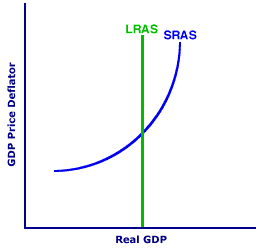
|
|
FACTOR MARKET EQUILIBRIUM: Equilibrium in the factor market, which for a perfectly competitive market is achieved at the factor price and factor quantity give by the intersection of the factor demand curve and the factor supply curve. For factor markets that are not perfectly competitive, such as those controlled by monopoly or monopsony, factor market equilibrium is achieved when the controlling firm maximizes profit. For monopoly, this is the factor quantity that equates marginal revenue and marginal cost. For monopsony, this is the factor quantity that equates marginal revenue product with marginal factor cost. But regardless of marginal structure, as an equilibrium it is maintained until shocked by an external force.
Visit the GLOSS*arama
|
|


|

|
                           SELF CORRECTION, INFLATIONARY GAP: The automatic process in which the aggregate market eliminates an inflationary gap created by a short-run equilibrium that is greater than full employment through increases in wages (and other resource prices). The self-correction mechanism is triggered by short-run resource market imbalances that are closed by long-run price flexibility. The self-correction process of the aggregate market also acts to close a recessionary gap with lower wages (and other resource prices). Self correction is seen as shifts of the short-run aggregate supply curve caused by changes in wages and other resource prices. The self-correction mechanism acts to close an inflationary gap with higher wages and a decrease in the short-run aggregate supply curve.With an inflationary gap, short-run equilibrium real production is greater than full-employment real production, meaning resource markets have shortages. In particular, labor is overemployed. Self correction is the process in which these temporary imbalances are eliminated through flexible prices as the aggregate market achieves long-run equilibrium. The key to this process is that changes in wages and other resource prices cause the short-run aggregate supply curve to shift. | Closing An Inflationary Gap |  |
The self-correction closure of an inflationary gap in the aggregate market can be illustrated using the exhibit to the right. The vertical axis measures the price level (GDP price deflator) and the horizontal axis measures real production (real GDP). This graph presents the two aggregate supply curves--long run and short run--but no aggregate demand curve. The vertical curve labeled LRAS is the long-run aggregate supply curve which marks full-employment real production. The positively-sloped curve labeled SRAS is then the short-run aggregate supply curve. The positioning of the aggregate demand curve and the point of intersection with the short-run aggregate supply curve indicates the inflationary gap. - Inflationary Gap: Click the [Inflationary Gap] button to reveal this output gap. With an inflationary gap, short-run equilibrium real production is greater than full-employment real production, meaning resource markets have shortages, and in particular labor is overemployed.
- Closing the Gap: In the long-run, this inflationary gap is closed with higher wages and a decrease in short-run aggregate supply. To illustrate this result, click the [Higher Wages] button. This button-clicking shifts the short-run aggregate supply curve to the left. A new equilibrium is achieved by the intersection of the new SRAS curve and the original AD curve. This intersection also coincides with the LRAS curve.
In the long run, wages and resource prices are flexible and they decline enough to eliminate imbalances in the resource markets. The result of rising wages (and other resource prices) is a boost in production cost. An increase in production cost causes a decrease in short-run aggregate supply, or a leftward shift of the SRAS curve.Note that the SRAS curve shifts leftward until it intersects BOTH the LRAS and AD curves at full-employment real production, which is long-run equilibrium. In particular, the new long-run equilibrium is at the full-employment level of real production. The SRAS curve absolutely MUST shift until this long-run equilibrium is reached. If the aggregate market does NOT reach long-run equilibrium, resource market imbalances persist, resource prices and production cost rise further, and the SRAS curve shifts more. However, once long-run equilibrium is reached, resource market imbalances are eliminated, resource prices and production cost do not change, and the SRAS curve does not shift any further.

Recommended Citation:SELF CORRECTION, INFLATIONARY GAP, AmosWEB Encyclonomic WEB*pedia, http://www.AmosWEB.com, AmosWEB LLC, 2000-2025. [Accessed: June 30, 2025].
Check Out These Related Terms... | | | | | | | |
Or For A Little Background... | | | | | | | | | | | | | | | | | | |
And For Further Study... | | | | | |
Search Again?
Back to the WEB*pedia
|



|

|
BEIGE MUNDORTLE
[What's This?]
Today, you are likely to spend a great deal of time watching infomercials hoping to buy either a black duffle bag with velcro closures or any book written by Isaac Asimov. Be on the lookout for slightly overweight pizza delivery guys.
Your Complete Scope
This isn't me! What am I?
|

|
|
The Dow Jones family of stock market price indexes began with a simple average of 11 stock prices in 1884.
|

|
|
"I learned about the strength you can get from a close family life. I learned to keep going, even in bad times. I learned not to despair, even when my world was falling apart. I learned that there are no free lunches. And I learned the value of hard work. " -- Lee Iacocca
|

|
PSBR
Public Sector Borrowing Requirement
|

|
|
Tell us what you think about AmosWEB. Like what you see? Have suggestions for improvements? Let us know. Click the User Feedback link.
User Feedback
|


|


